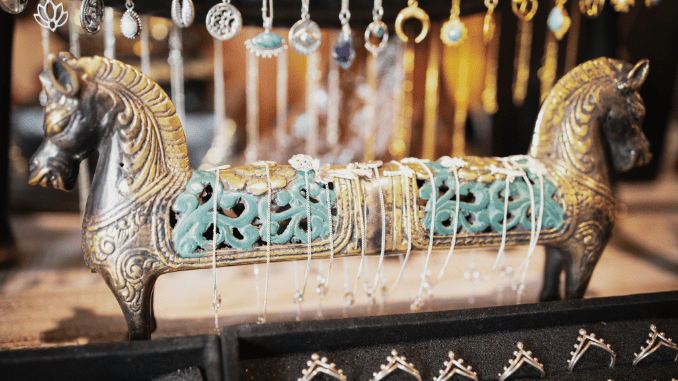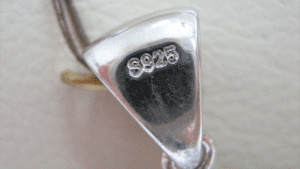
Introduction
Silver is not only used for making jewelry but also is required for many industrial purposes like batteries, dentistry, nuclear reactors to photography (1). However, the pure form of silver is very soft as well as expensive and can not fulfill the demands of the growing industries. Thus, alloys of silver are widely used (2). Standard sterling silver alloys or what we call sterling silver 925 mainly contain silver (92.5 wt% Ag) and Copper (7.5 wt% Cu) (3).
What is Sterling Silver?
Sterling silver is an alloy of silver. And contains 92.5% of silver by mass and 7.5% by mass of other metals, usually copper. The sterling silver originated from continental Europe. Silver is a pure metal, which is why it is typically alloyed with copper to increase its hardness and strength. Sterling silver is prone to tarnishing, and elements apart from copper can be used in alloys to reduce tarnishing.
Silver is a very soft, ductile, malleable, and lustrous metal. It’s a more reactive metal than gold, and also harder to extract from its ores when mined. Sterling silver is much more suitable to use in jewelry and other metalwork. Most silver jewelry will be of sterling silver. The sterling silver metal will not rust and perish.
The difference between silver and sterling silver is in the percentage of other metals. Most silversmiths prefer using copper with silver because of its non-reactive properties for sensitive skin. The additional metals used in jewelry could be zinc or nickel.
What is silver?
Silver is an element with the symbol Ag. Its atomic number is 47. It is a soft, white, lustrous, and transition metal. Its group number is 11. It has the highest electrical conductivity, thermal conductivity, and reflectivity of any metal. It is found in the earth’s crust in pure form. Most silver is produced as a by-product of copper, gold, lead, and zinc refining (4).
It’s a diamagnetic material. Silver is used in solar panels, water filtration, jewelry ornaments, high-table-value tableware, etc. Silver does not react with air even at red heat and thus was considered by alchemists as a noble metal along with gold. (Atomic weights and isotopic compositions for all elements. IUPAC).
The common oxidation states of silver are(in order of commonness): +1 (the most stable state for example:- silver nitrate, AgNo3); +2 (highly oxidizing for example:- Silver fluoride AgF2); +3 (extreme oxidizing for example:- chlorine tetrafluoroargentate, KAgF3). (Standards atomic weight: Silver CIAAW. 1985.)
What is sterling silver 925?
Sterling silver is an alloy made up of 92.5% of pure silver and 7.5% of other metals, usually copper or zinc. Sterling silver is known as a metal alloy.
Uses of sterling silver 925
- Jewelry
- Silverware
- Plates
- Platter Platters
- Coffee seats
- Silver plated items
Tarnishing
Sterling silver is more easily tarnished than pure silver. Copper, Nickel, and Zinc are easily tarnished.
Stamp

Sterling silver is also stamped to indicate that it is a true sterling silver. These stamps are typically “925”, “92.5” or “.925” to indicate the purity of silver within it.
Why do you use sterling silver instead of pure silver?
There are a few benefits of sterling silver
- Fine silver has a pure purity percentage of silver. Therefore, sterling silver is of low cost.
- There’s also the durability factor. Sterling silver is much more durable compared to fine silver because of the added metal alloys.
- Sterling silver is easier to shape than soft and malleable fine silver.
- 925 sterling silver is made to last for a long.
- Every sterling silver jewelry comes with a 925 authenticity, and it is hallmarked as well.
- Sterling silver is a versatile alloy. Sterling Silver is one of the best students in the class of metals.
- Sterling silver is easy to maintain.
Durability and purity of sterling silver
- Sterling silver gains significant strength and durability due to the incorporation of metal alloys, setting it apart from fine silver.
- Among the various metals used to create alloys for sterling silver, copper stands as the most popular choice, providing exceptional stability, longevity, and durability, ensuring the production of enduring high-quality sterling silver pieces.
- Consistently wearing sterling silver jewelry can effectively prevent dullness and the occurrence of unsightly scratches.
- Sterling Silver 925, being a highly resilient metal, tends to resist tarnishing, discoloration, or developing a black or green patina if it receives proper care and is worn regularly.
Key points to identify sterling silver jewelry
1. In the odor test, sterling silver is odorless, if it can smell sulfur or a distinct metallic fragrance, then it is not sterling silver.
2. Check the purity of sterling silver.
3. Look for markings and stamps on the sterling silver.
The magnet test “if your magnet sticks Strongly to the piece, it is a ferromagnetic core, then it is not sterling silver. Because real sterling silver is not drawn to magnetic force.
Difference between silver and sterling silver 925
Silver |
Sterling silver 925 |
| Pure silver is heavy. | It is lightweight. |
| It is magnetic | It is non-magnetic |
| Stamp-999 | Stamp-925 |
| Lasts a lifetime with proper care. | Durable, so lasts a lifetime. |
| Soft and malleable, so easily loses shape. | The jewelry is often silver-plated. |
| Has a silvery gray appearance. | These have a characteristic shiny appearance. |
How to take care of sterling silver 925 jewelry
Some key points to taking care of sterling silver
1. Store carefully
Storing jewelry properly is also very important. When not wearing should store it well in an airtight container to keep away from moisture.
2. Clean using a soft cloth
Polishing your silver jewelry with a soft cloth is an effective way to keep your jewelry shining for years.
3. Keep away from other metals
Sterling silver may react with other metals and lose its shine. Therefore, you should keep away from it with other metals.
4. Take off your jewelry
Wearing your sterling silver jewelry on a regular basis may expose it too. So ensure you remove your jewelry immediately after using them.
Q&A
How much is 925 silver worth?
It depends on the weight of the item. If sterling silver weight is 100 grams would be worth around $80. The worth increases or decreases with the weight of the item.
How much is 1 gram of 925 sterling silver worths?
1 gram of 925 sterling silver worth is $0.71 or 71₹.
Is 925 sterling good silver quality?
Sterling silver is less pure than silver, but it. not mean it’s not good. Sterling silver is a high-quality metal that’s both durable and beautiful to wear.
Is sterling silver real silver?
Yes, the sterling silver is a real silver. Sterling silver is simply an alloyed form of silver which is much more suitable to use in jewelry and other metalwork.
Is 925 sterling silver 925 expensive?
925 sterling silver is less expensive because copper and other metals are added to it. Also, it is less expensive than pure silver.
Why is 925 silvers so cheap?
Sterling silver is inexpensive compared with other metals because sterling silver is an alloy which is a mixture of other metals. The metals used in making sterling silver are much less expensive than silver.
Summary
- Sterling silver is an alloy of 92.5% of silver and 7.5% of other metals.
- It is a very soft, ductile, and malleable alloy.
- It is less expensive and more beautiful to wear.
- Furthermore, it has many uses for jewelry purposes, silverware, etc. Likewise, It is a versatile metal and easy to maintain.
- It gives excellent durability, stability, and longevity.
- Wearing sterling silver every day will help to prevent dullness and scratches.
- It is lightweight and non-magnetic. Sterling silver should be stored carefully, cleaned with a soft cloth, and kept away from other metals for long-lasting use.
